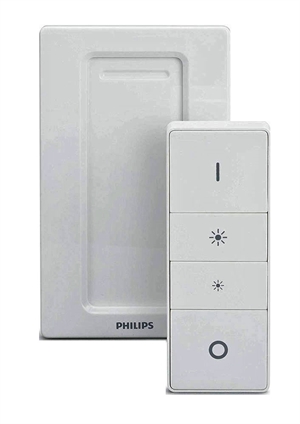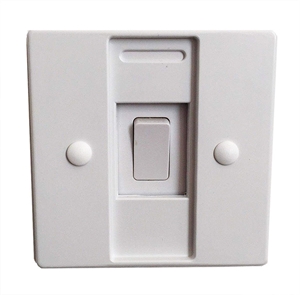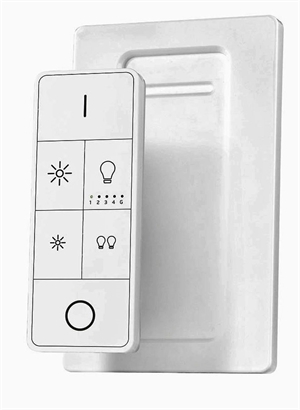Philips Hue
The Philips Hue range warrants special mention on two counts. Firstly, the control system supports several Application Profiles, including Home Automation and Light Link, so it does not require a bridge to control the Philips Hue range of devices. Secondly, the Philips Hue switch enables smart bulbs to be used without the risk of them being switched off manually, and avoids the need for any rewiring of the lighting circuits.
Philips Hue Smart Bulbs
Several Philips Hue smart bulbs have been tested successfully with the system. All of the tested Philips Hue smart bulbs report any change in their state to the hub, when a change occurs. This may occur automatically when the state changes, or when it is interrogated by the hub.
All of the Philips Hue smart bulbs communicate with the control system running on the hub, either directly or via repeaters / routers. This communication does not require a Philips Hue Bridge, because the software supports several Application Profiles, including Home Automation and Light Link. Other hubs may only support Home Automation.
Philips Hue Switch

The Philips Hue smart bulbs can be controlled with a battery powered Philips Hue switch. This can switch the smart bulbs on and off, and can change the brightness of dimmable bulbs. It can control an individual bulb, or a group of bulbs.
Although the Philips Hue switch is designed to perform the on / off and brightness functions, the use of the switch can be interpreted differently by the control system. For example, the dimming switches can be used to sequence through a range of predefined settings, such as for different moods for a groups of smart bulbs.
As with any ZigBee compliant device, the Philips Hue switch can be paired with another ZigBee device, including the control system running on the hub. If the switch is paired with the control system, then it can be used to control any device connected to the system, and especially any smart bulb, including Hive, Osram, and other brands, or any normal bulb controlled by a smart manual switch or smart relay.
Again, being ZigBee compliant, the Philips Hue switch commands can also be relayed through any repeater / router, such as a Hive or Iris smart plug.
Switch Cover Plates
The Philips Hue switch is supplied with a standard wall mounting plate. The switch is attached to this plate by a key way register at the top of the switch, and a magnet at the bottom of the switch. The magnet holds the switch firmly in place, while still enabling it to be easily removed from its housing, when needed.

The supplied cover plate appears to be intended for the US market.
Special cover plates have been manufactured by third parties for use with the Philips Hue switches in the UK. These are attached over the existing manual switch plate using the two standard cover plate fixing screws. These cover plates are designed so that the Philips Hue switch covers the existing manual switch, but can be easily removed to operate the manual switch, if needed.
This design overcomes one of the main issues with any smart bulb, which is that it can be switched off via the manual wall switch. When this occurs, the bulb loses connection with the network, and the hub. If it remains in this state for an extended period of time, it then has to be re-joined to the network, which is a significant inconvenience.
As this enables more reliance to be placed on the use of smart bulbs, it also avoids the need for alternative means of controlling the lighting, all of which require some degree of modification to the electrical wiring, and require a skilled electrician.
Trust Smart Switch

The Trust ZYCT-202 smart switch, which has also been tested, is sold as being compatible with Philips Hue smart bulbs.
The Trust switch has more functionality than the Philips Hue switch, because it can separately control up to 5 individual bulbs, or up to 5 groups of bulbs. As with the Philips Hue switch, it can switch the bulbs on and off, and adjust their brightness, but it cannot control their colour.
This mechanical design of the Trust switch is slightly different to the Philips Hue switch, which makes it physically incompatible with UK wall switches, so it cannot be fitted in the same way as that described above for the Philips Hue switch. It appears to be compatible with US switches, and has presumably been designed for that market.
The Trust switch is also not as compliant with the ZigBee standard as the Philips Hue switch. Technically, it does respond to the control system in the same way as a normal ZigBee device.
It can also only be paired with Philips Hue or Trust bulbs, and not with the control system.
To pair the Trust switch with each smart bulb, it is placed in close proximity to the target bulb during the joining process. Once paired, the switch commands can only be sent to any paired bulb(s).
The Trust switch does comply with the ZigBee mesh specification to the extent that its commands can be relayed through any repeater / router, such as a Hive or Iris smart plug, to the paired bulb(s). This enables the switch to be physically separated from the bulb(s) under its control by some distance.
The control system can separately communicate with the smart bulbs. It can control them, determine their current state of any smart bulb, and any changes to their states, effectively operating as another smart switch to control the smart bulbs, alongside the Trust switch.
The Trust switch lacks the flexibility and capability of other switches and buttons, such as the Philips Hue switch and the Osram Lightify 4 button pad, and many others, all of which can be used to control any device on the network.